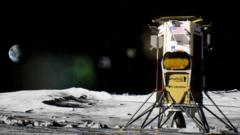23 minutes ago
About sharing
An American company has made history by becoming the first commercial outfit to put a spacecraft on the Moon.
Houston-based Intuitive Machines landed its Odysseus robot near the lunar south pole.
It took some minutes for controllers to confirm the craft was down, but eventually a signal was received.
“What we can confirm, without a doubt, is our equipment is on the surface of the Moon and we are transmitting,” flight director Tim Crain announced.
Staff at the company cheered and clapped at the news.
It was an important moment, not just for the commercial exploitation of space but for the US space programme in general.
Intuitive Machines has broken the United States’ half-century absence from the Moon’s surface. You have to go back to the last Apollo mission in 1972 for an occasion when American hardware nestled down gently in the lunar soil.
The US space agency Nasa had purchased space on Odysseus for six scientific instruments, and its administrator Bill Nelson was quick to add his congratulations on what he described as a “triumph”.
“The US has returned to the Moon,” he said. “Today, for the first time in the history of humanity, a commercial company – an American company – launched and led the voyage up there. And today is the day that shows the power and promise of Nasa’s commercial partnerships.”
Odysseus touched down at 23:23 GMT. At first there was no confirmation signal from the robot, and controllers had to wait several minutes before picking one up – and it was faint.
This will lead to some concerns about the status of the lander. Engineers will be going back through the data in the coming hours to try to understand precisely what happened – and to check that Odysseus is upright and collecting energy properly through its solar cells.
The targeted landing site was cratered terrain next to a 5km-high mountain complex known as Malapert. It’s the southernmost point on the Moon ever visited by a spacecraft, at 80 degrees South.
Nasa’s six payloads on board are a mix of technology demonstration and science.
A key investigation will be one looking at the behaviour of lunar dust, which the Apollo astronauts found to be a serious nuisance, scratching and clogging their equipment.
The agency’s scientists want to understand better how the dust is kicked up by landing craft to hang just above the surface before then settling back down.
The six commercial payloads on board include a student camera system from Embry-Riddle Aeronautical University, which should have been deployed from Odysseus when it was still 30m above the lunar surface.
The system was designed to take selfie images as the robot set itself down.
The American artist Jeff Koons has also attached a box to the side of the lander that contains 125 small stainless steel balls to represent the Moon’s different phases through a month.
Related Topics
15 February
